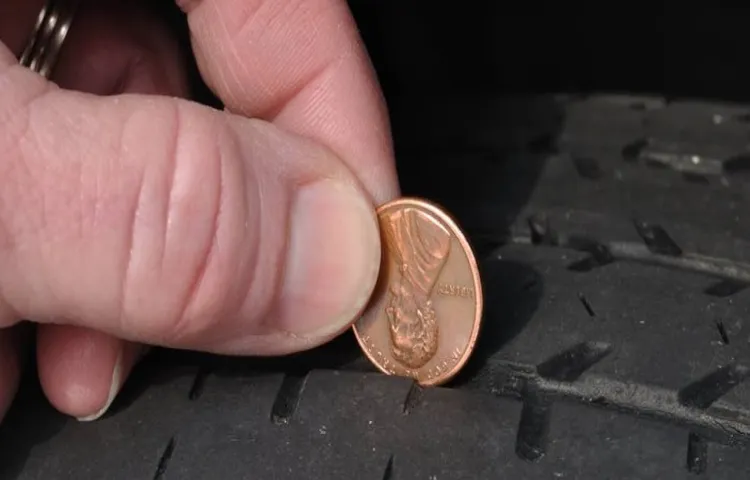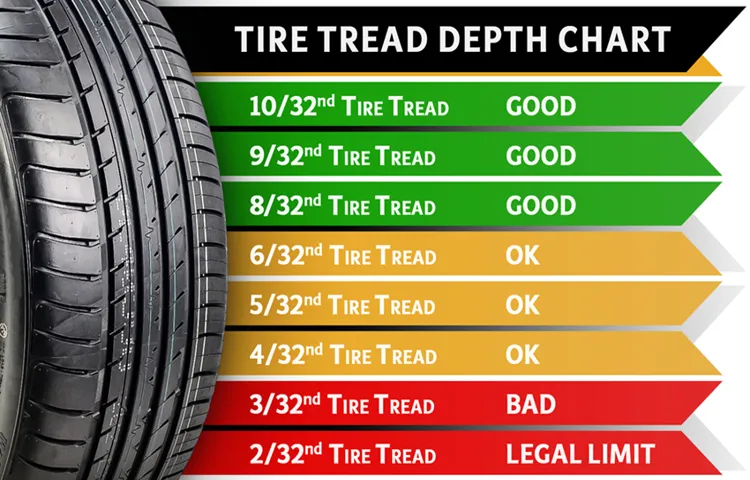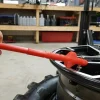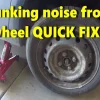As a Pennsylvania driver, you know how crucial it is to keep up with state inspection requirements to legally operate your vehicle. One component of the inspection that can often go overlooked is tire tread depth. It’s easy to overlook the condition of your tires, but doing so can put yourself and others on the road at risk.
In this blog post, we’ll go over Pennsylvania’s tire tread depth requirements for inspection and why they matter. So, buckle up and let’s dive in!
Table of Contents
What is Pennsylvania’s Inspection Requirement?
If you’re a driver in Pennsylvania, it is essential to know the state’s inspection requirements. One of the most critical aspects of the yearly inspection is your car’s tire tread depth. By law, your tires must have a minimum tread depth of 2/32 inch to pass inspection.
This depth is about the same as the head of a penny or a credit card. However, it is important to note that the 2/32 inch depth is the absolute bare minimum required by the state. It is always best to maintain your tires with a minimum depth of 4/32 inch for safety reasons.
Driving with tires that have worn below the surface could lead to serious accidents, especially in wet or snowy weather conditions. Therefore, it is vital to ensure that your tires have enough tread depth, especially when it is time for inspection.
Understanding Pennsylvania Inspection Requirements
If you are a car owner in Pennsylvania, it’s important to understand the state’s inspection requirements. All vehicles in Pennsylvania, except for motorcycles, must undergo a safety inspection once a year. This inspection includes checking various components of your vehicle to ensure they are working properly and meet the state’s safety standards.
Some of the items checked during the inspection include the seat belts, brakes, tires, lights, and windshield wipers. The inspection also includes an emissions test, which is required for vehicles in certain counties. Ensuring that your vehicle passes the state’s inspection is crucial to avoiding penalties and keeping yourself and other drivers safe on the road.
So, be sure to schedule your inspection with a certified inspection station and make any necessary repairs before your inspection date to avoid any potential issues.

What is the Minimum Tire Tread Depth to Pass?
In Pennsylvania, the minimum tire tread depth to pass inspection is 2/32 of an inch. This means that the tire tread must have at least 2/32 of an inch of depth in every major groove. It’s important to keep in mind that this is the bare minimum requirement and it’s recommended to replace your tires before they reach this point to ensure optimal safety on the road.
If you’re unsure whether your tires meet the minimum requirement, you can use a penny to check. Simply insert the penny into the groove with Lincoln’s head upside down and facing you. If you can see the top of Lincoln’s head, your tire tread is too low and it’s time to replace your tires.
It’s important to take tire tread depth seriously as it affects your vehicle’s handling, traction, and overall safety on the road. So, make sure to check your tires regularly and don’t hesitate to replace them when necessary.
How to Check the Tire Tread Depth?
If you are wondering how much tire tread to pass inspection in PA, the answer is at least 2/32 of an inch. But instead of waiting for the inspection, why not learn how to check the tire tread depth yourself? It’s an easy process that you can do with just a penny. Simply place the penny, with Lincoln’s head facing down, into the grooves of your tire.
If the tread covers Lincoln’s head, you’re good to go. If not, it’s time to replace your tires. Checking your tire tread is essential for your safety on the road, as worn-out tires can lead to reduced traction and longer stopping distances.
Don’t wait for the inspection to tell you it’s time to replace your tires. Take two minutes and check them yourself for peace of mind.
Step-by-Step Instructions to Check Tread Depth
If you’re wondering whether it’s time to replace your old tires or not, checking the tread depth is the first step. Tread depth is essential for maintaining traction on the road, especially in wet or icy conditions. Checking the depth may seem daunting at first, but it’s a simple process that you can do at home.
First, you need to find a penny or quarter, and insert it into the tread groove. If you can see the top of the head on the penny or Washington’s hairline on the quarter, it’s time to get new tires. The minimum tread depth required by federal law is 2/32″, but many experts suggest you replace tires once they reach 4/32″ to ensure maximum safety.
Remember, better tread depth means better handling and braking, so don’t neglect this important maintenance task.
Tools Needed for Checking Tread Depth
One of the essential tasks that every car owner should perform is checking the tire tread depth regularly. Tires with worn-out treads can cause accidents, especially on slippery or wet roads, due to reduced grip and traction. To check the tire tread depth, you will need a few tools such as a ruler, penny, tread depth gauge, or quarter.
The rule of thumb for checking the tire tread depth is that it should not be less than 2/32 of an inch. Using a penny, place it in between the tread blocks with Lincoln’s head pointing downwards. If you can see the top of Lincoln’s head, then the tires are worn and require replacement.
For a more accurate reading and to check different spots on the tire, use a tread depth gauge. Place the probe into the grooves and take readings in different locations on the tire to ensure uniform wear. By regularly checking the tire tread depth, you can ensure safe driving and avoid potential accidents caused by worn-out tires.
How to Know When to Replace Your Tires?
When it comes to safety on the road, having good-quality tires is essential. One way to assess the condition of your tires is by checking the tire tread depth. Tread depth is the vertical measurement between the top of the tire tread to the bottom of the tire’s deepest grooves.
By checking the depth, you can determine whether it’s time to replace your tires. To check the tread depth, you can use a tire tread depth gauge or simply a penny. If you’re using a penny, you can insert the coin into the tread groove with Lincoln’s head facing down.
If you can see the top of Lincoln’s head, then it’s time for new tires. If the tread covers part of Lincoln’s head, then you’re good to go. The recommended tire tread depth is 2/32 of an inch or more.
Anything less than that could compromise your car’s stability, handling, and traction on wet or slippery roads. It’s also important to check the tread depth regularly, especially before long trips or when driving in extreme weather conditions. Other signs that may indicate the need for new tires include uneven tread wear, cuts, cracks, bulges, and vibrations.
If you notice any of these issues, it’s crucial to have your tires inspected by a professional mechanic. Remember, your tires are your car’s only contact with the road, so make sure they’re in good shape. By checking the tread depth, you can take proactive steps to ensure your safety and the safety of others while driving.
Consequences of not Meeting Pennsylvania Inspection Requirement?
In Pennsylvania, it is essential to meet state vehicle inspection requirements. Failure to do so can result in several consequences that can negatively affect you and your vehicle. One such requirement is having enough tire tread to pass inspection.
Pennsylvania requires vehicles to have a minimum of 2/32 inches of tire tread on all tires to pass inspection successfully. If your vehicle fails to meet this requirement, you may face a fine or have your registration suspended. Even worse, driving with insufficient tire tread can be a significant safety hazard, putting yourself and others at risk.
It can lead to a loss of control of the vehicle, difficulty braking, and hydroplaning in wet conditions. To ensure your safety and avoid any legal or financial penalties, it is crucial always to maintain your vehicle and meet inspection requirements.
Fines and Penalties for Not Meeting Inspection Requirements
If you fail to meet the inspection requirements set by the Pennsylvania Department of Transportation, there can be serious consequences. These consequences can range from fines to penalties and may even result in your vehicle being impounded. Fines can vary based on the severity of the violation and can add up quickly.
However, penalties can take an even greater toll on you and your wallet. Failing to meet inspection requirements can result in your vehicle being deemed unsafe to operate, which means not only will you be unable to legally drive it, but you’ll also need to get it repaired and re-inspected, which can be a costly and time-consuming process. It’s important to treat inspections seriously and take care to ensure that your vehicle meets all necessary requirements before it’s too late.
So, if you’re driving in Pennsylvania, make sure to keep up with your vehicle’s inspections to avoid any penalties or fines.
Risk of Driving on Bald Tires
Driving on bald tires is not only illegal but also extremely dangerous. In Pennsylvania, cars must pass an annual safety inspection before they can be legally driven on the road. One of the requirements of this inspection is that all tires be properly inflated and have a minimum tread depth of 2/32 of an inch.
Driving on bald tires can lead to several consequences, including loss of traction, reduced handling, and longer stopping distances. In wet or slippery conditions, bald tires can easily hydroplane, making it nearly impossible to control the car. In addition, being caught driving on bald tires can result in a fine and even points on your driver’s license.
It’s crucial to ensure that your vehicle is in compliance with Pennsylvania’s inspection requirements to prevent accidents and stay safe on the road. Remember, the cost of replacing tires is far less than the cost of an accident caused by bald tires.
Conclusion
Well, my dear friend, it all comes down to the age-old question: to tread or not to tread? In the great state of Pennsylvania, the answer is clear – your tire tread must be at least 2/32 of an inch deep to pass inspection. But let’s not forget that it’s not just about passing an inspection – it’s about keeping yourself and others safe on the road. So, be sure to inspect your tires regularly and replace them when necessary.
After all, nothing is more important than having a solid grip on the road and avoiding those pesky hydroplaning situations. Stay safe out there, my fellow drivers!”
FAQs
1. What is the minimum tire tread depth required to pass inspection in Pennsylvania? A: The minimum tire tread depth required by law in Pennsylvania is 2/32 of an inch. 2. Can I still drive my car if the tire tread depth is less than 2/32 of an inch? A: No, you should replace your tires immediately if they don’t meet the minimum tire tread depth required by law. 3. How can I check my tire tread depth at home? A: You can use a penny or a tread depth gauge to measure the depth of your tire tread. 4. What is the penalty for driving with tires that don’t meet the minimum tread depth in Pennsylvania? A: The penalty for driving with unsafe tires can include fines and suspension of your driver’s license and registration. 5. How often should I have my tires inspected in Pennsylvania? A: You should have your tires inspected once a year as part of your vehicle safety inspection. 6. Can I use snow tires to pass the tire tread depth inspection in Pennsylvania? A: Yes, as long as the snow tires meet the minimum tire tread depth requirement of 2/32 of an inch. 7. What should I do if I fail the tire tread depth inspection in Pennsylvania? A: If you fail the tire tread depth inspection, you should have your tires replaced before driving your vehicle on the road.



